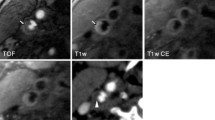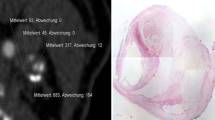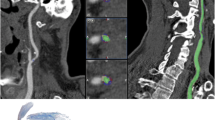Abstract
Purpose
We investigated the agreement of dual-energy computed tomography angiography (DE-CTA) and contrast-enhanced magnetic resonance angiography (CE-MRA)in the quantitative measurement of stenoses of the internal carotid artery in comparison with digital subtraction angiography (DSA).
Methods
A total of 21 patients with stenoses of the external carotid artery were investigated with a DE-CTA and CE-MRAbefore undergoing carotid angioplasty. The grade of the stenoses was assessed in axial multiplanar reformations (MPR) before and multi-intensity projections (MIP) after plaque subtraction (PS) and compared with results from CE-MRA and DSA according to the North American Symptomatic Carotid Endarterectomy Trial.
Results
Average grades of stenoses were 80.7 ± 16.1 % (DSA), 81.4 ± 15.3 % (MRA), 80.0 ± 16.7 % (DE-CTA-MPR), and 85.2 ± 14.7 % (DE-CTA-PS-MIP). Of 21 stenoses, 6 were filiform (stenosis grade, 99 %) in the DSA examination. Five of these cases were identified as pseudo-occlusions in MRA, while four were considered as occlusions in DE-CTA-PS-MIP. Another four cases were identified as pseudo-occlusion in DE-CTA-PS-MIP, which were identified as 90 % stenosis in the DSA examination.
Conclusions
In comparison with the gold standard DSA, DE-CTA-MPR had a slightly better agreement in measuring the degree of stenosis of the internal carotid arteries than CE-MRA. In DE-CTA-PS-MIP images, a systematic overestimation has to be taken into account due to partial extinction of the lumen by the PS algorithm. Nevertheless, DE-CTA should be preferred in imaging patients with carotid artery stenosis in the presence of extensive calcifications.





Similar content being viewed by others
References
Rosamond W, Flegal K, Furie K, Go A, Greenlund K, Haase N, et al. Heart disease and stroke statistics- 2008 update: a report from the American Heart Association Statistics Committee and Stroke Statistics Subcommittee. Circulation. 2008;117:e25–146.
European Carotid Surgery Trialists’ Collaborative Group. MRC European carotid surgery trial: interim results for symptomatic patients with severe (70–99 %) or with mild (0–29 %) carotid stenosis. Lancet. 1991;337:1235–43.
North American Symptomatic Carotid Endarterectomy Trial Collaborators. Beneficial effect of carotid endarterectomy in symptomatic patients with high-grade carotid stenosis. N Engl J Med. 1991;325:445–53.
North American Symptomatic Carotid Endarterectomy Trial Collaborators. Benefit of carotid endarterectomy in patients with symptomatic moderate or severe stenosis. N Engl J Med. 1998;339:1415–25.
Executive Committee for the Asymptomatic Carotid Atherosclerosis Study. Endarterectomy for asymptomatic carotid artery stenosis. JAMA. 1995;273:1421–8.
Willinsky RA, Taylor SM, TerBrugge K, Farb RI, Tomlinson G, Montanera W. Neurologic complications of cerebral angiography: prospective analysis of 2,899 procedures and review of the literature. Radiology. 2003;227:522–8.
Dawkins AA, Evans AL, Wattam J, Romanowski CA, Connolly DJ, Hodgson TJ, et al. Complications of cerebral angiography: a prospective analysis of 2,924 consecutive procedures. Neuroradiology. 2007;49:753–9.
Cumming MJ, Morrow IM. Carotid artery stenosis: a prospective comparison of CT angiography and conventional angiography. AJR Am J Roentgenol. 1994;163:517–23.
Koelemay MJ, Nederkoorn PJ, Reitsma JB, Majoie CB. Systematic review of computed tomographic angiography for assessment of carotid artery disease. Stroke. 2004;35:2306–2.
Alvarez-Linera J, Benito-León J, Escribano J, Campollo J, Gesto R. Prospective evaluation of carotid artery stenosis: elliptic centric contrast-enhanced MR angiography and spiral CT angiography compared with digital subtraction angiography. AJNR Am J Neuroradiol. 2003;24:1012–9.
Chappell FM, Wardlaw JM, Young GR, Gillard JH, Roditi GH, Yip B, et al. Carotid artery stenosis: accuracy of noninvasive tests–individual patient data meta-analysis. Radiology. 2009;251:493–502.
Tartari S, Rizzati R, Righi R, Deledda A, Capello K, Soverini R, et al. High-resolution MRI of carotid plaque with a neurovascular coil and contrast-enhanced MR angiography: one-stop shopping for the comprehensive assessment of carotid atherosclerosis. AJR Am J Roentgenol. 2011;196:1164–71.
Romero JM, Babiarz LS, Forero NP, Murphy EK, Schaefer PW, Gonzalez RG, et al. Arterial wall enhancement overlying carotid plaque on CT angiography correlates with symptoms in patients with high grade stenosis. Stroke. 2009;40:1894–6.
McKinney AM, Casey SO, Teksam M, Lucato LT, Smith M, Truwit CL, et al. Carotid bifurcation calcium and correlation with percent stenosis of the internal carotid artery on CT angiography. Neuroradiology. 2005;47:1–9.
Kwee RM. Systematic review on the association between calcification in carotid plaques and clinical ischemic symptoms. J Vasc Surg. 2010;51:1015–25.
Marks MP, Napel S, Jordan JE, Enzmann DR. Diagnosis of carotid artery disease: preliminary experience with maximum-intensity-projectionspiral CT angiography. AJR Am J Roentgenol. 1993;160:1267–71.
Johnson TR, Krauss B, Sedlmair M, Grasruck M, Bruder H, Morhard D, et al. Material differentiation by dual energy CT: initial experience. Eur Radiol. 2007;17:1510–7.
Flohr TG, McCollough CH, Bruder H, Petersilka M, Gruber K, Süss C, et al. First performance evaluation of a dual-source CT (DSCT) system. Eur Radiol. 2006;16:256–68.
Brockmann C, Scharf J, Nölte IS, Seiz M, Groden C, Brockmann MA. Dual-energy CT after peri-interventional subarachnoid haemorrhage: a feasibility study. Clin Neuroradiol. 2010;20:231–5.
Uotani K, Watanabe Y, Higashi M, Nakazawa T, Kono AK, Hori Y, et al. Dual-energy CT head bone and hard plaque removal for quantification of calcified carotid stenosis: utility and comparison with digital subtraction angiography. Eur Radiol. 2009;19:2060–5.
Thomas C, Korn A, Ketelsen D, Danz S, Tsifikas I, Claussen CD, et al. Automatic lumen segmentation in calcified plaques: dual-energy CT versus standard reconstructions in comparison with digital subtraction angiography. AJR Am J Roentgenol. 2010;194:1590–5.
Korn A, Bender B, Thomas C, Danz S, Fenchel M, Nägele T, et al. Dual energy CTA of the carotid bifurcation: advantage of plaque subtraction for assessment of grade of the stenosis and morphology. Eur J Radiol. 2011;80:e120–5.
Behrendt FF, Schmidt B, Plumhans C, Keil S, Woodruff SG, Ackermann D, et al. Image fusion in dual energy computed tomography: effect on contrast enhancement, signal-to-noise ratio and image quality in computed tomography angiography. Invest Radiol. 2009;44:1–6.
Cohen J. Weighted kappa: Nominal scale agreement provision for scaled disagreement or partial credit. Psychological Bull. 1968;70(4):213–20.
Brenner H, Kliebsch U. Dependence of weighted kappa coefficients on the number of categories. Epidemiology. 1996;7:199–202.
Puppini G, Furlan F, Cirota N, Veraldi G, Piubello Q, Montemezzi S, et al. Characterization of carotid atherosclerotic plaque: comparison between magnetic resonance imaging and histology. Radiol Med. 2006;111:921–30.
Kopps A, Ittrich H, Petri S. Multicontrast-weighted magnetic resonance imaging of atherosclerotic plaques at 3.0 and 1.5 T: ex vivo comparison with histopathologic correlation. Eur Radiol. 2007;17:279–86.
Das M, Braunschweig T, Mühlenbruch G, Mahnken AH, Krings T, Langer S, et al. Carotid plaque analysis: comparison of dual-source computed tomography (CT) findings and histopathological correlation. Eur J Vasc Endovasc Surg. 2009;38:14–9.
Nandalur KR, Baskurt E, Hagspiel KD, Phillips CD, Kramer CM. Calcified carotid atherosclerotic plaque is associated less with ischemic symptoms than is noncalcified plaque on MDCT. AJR Am J Roentgenol. 2005;184:295–8.
Nederkoorn PJ, van der Graaf Y, Hunink MGM. Duplex ultrasound and magnetic resonance angiography compared with digital subtraction angiography in carotid artery stenosis. Stroke. 2003;34(5):1324–32.
Petersilka M, Bruder H, Krauss B, Stierstorfer K, Flohr TG. Technical principles of dual source CT. Eur J Radiol. 2008;68:362–8.
Elgersma OEH, Buijs PC, Wust AFJ, van der Graaf Y, Eikelboom BC, Mali WP. Maximum internal carotid arterial stenosis: assessment with rotational angiography versus conventional intraarterial digital subtraction angiography. Radiology. 1999;213:777–83.
Silvennoinen HM, Ikonen S, Soinne L, Railo M, Valanne L. CT angiographic analysis of carotid artery stenosis: comparison of manual assessment, semiautomatic vessel analysis, and digital subtraction angiography. AJNR Am J Neuroradiol. 2007;28:97–103.
Watanabe Y, Nagayama M. MR plaque imaging of the carotid artery. Neuroradiology. 2010;52:253–74.
Author information
Authors and Affiliations
Corresponding author
Rights and permissions
About this article
Cite this article
Korn, A., Bender, B., Brodoefel, H. et al. Grading of Carotid Artery Stenosis in the Presence of Extensive Calcifications: Dual-Energy CT Angiography in Comparison with Contrast-Enhanced MR Angiography. Clin Neuroradiol 25, 33–40 (2015). https://doi.org/10.1007/s00062-013-0276-0
Received:
Accepted:
Published:
Issue Date:
DOI: https://doi.org/10.1007/s00062-013-0276-0




